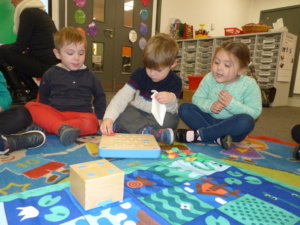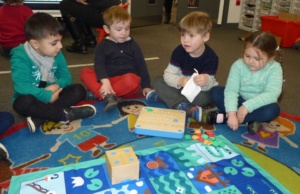
One approach is to introduce computer concepts in the early years through hands-on play. Computer programming is a case in point. There are many products on the market that let children use their brain and hands to create and manipulate code using physical objects. These include Logo, Bee Bot, floor turtles and now Cubetto.
Cubetto consists of two parts: the small wooden cube robot and a separate control board with different coloured tiles that slot into it. Each coloured block represents an action: green is forward, yellow is left, red is right, and blue is the function key. Put the blocks on the board to program Cubetto, hit the blue button and the robot will move.
Cubetto in a nursery
Richard Fitzwarine-Smith is an ambassador for Cubetto. He runs a company called Amazing ICT and introduces technology into school settings as well as providing training for teachers.

He took Cubetto into Grange Park Primary School nursery in Telford so nursery manager Donna Gray and pupils could see it in action. Eight children sat on the floor and Richard unrolled a mat with different symbols. ‘This is a swamp,’ he said. ‘What can you see?’ The children found trees, frogs, water, a bridge and a crocodile. Then he dug a little deeper and they suggested an alligator, an owl, flamingos, lily pads and insects.
He passed around Cubetto in its case and explained that they had to treat it with care. It is the only coding toy that can be used by sighted and non-sighted children in the same setting, creating an equal learning environment that promotes inclusive play.
Richard asked the children how they thought it might work and they talked confidently about switches and batteries. He put Cubetto on a lily pad, put one green tile into the control board and passed it to the first little boy who pressed the switch.
Cubetto moved forward one square and the children squealed in delight. Their excitement seemed surprising, given that many would have sophisticated plastic toys with all the commercial bells and whistles, possibly controlled via a joystick and capable of speeding away in different directions, instead of one step forward, two sideways etc. Perhaps it is the simplicity that appeals.
Cubetto came to some water and the children did swimming actions; they came to a tree and mimed climbing up and down. Then they came to the edge of the mat.
‘We have a problem,’ said Richard. Tell the friend next to you what the problem is.’ One little boy was far too excited to talk to just one person and, despite adult interventions, insisted on standing up and shouting out, ‘He’s going to fall off!’ ‘He’s got nowhere to go!
The emphasis throughout the session was on asking questions and encouraging children to think about what they could see and what might happen, rather than giving out instructions. This led to problem solving and hypotheses so children started to talk in terms of ‘could’ and ‘might’ and ‘perhaps’. It seemed that Cubetto provided a bridge between the physical and digital worlds.
Some parents are taking matters into their own hands and introducing Cubetto into the home so children begin to learn the skills they will need in the future. In this video, Emily Lofthouse talks about how Cubetto has encouraged her son to be more confident and independent and the impact she thinks these qualities will have on his future life.
If we want children to think critically, communicate ideas and opinions in a confident way and solve problems for themselves they need toys like Cubetto. These will develop the seeds of computational thinking, alongside characteristics such as the ability to work with others, to persevere and to plan ahead.
Register for free
No Credit Card required
- Register for free
- Free TeachingTimes Report every month